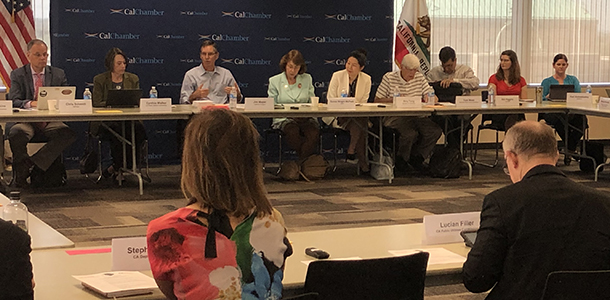
CA Fwd Senior Fellow Jim Mayer speaking at the Digital Inclusion Roundtable in Sacramento June 19 (Photo: Susan Lovenburg/CAFwd)
In a day marked by creativity, candor and collaboration, broadband stakeholders came together during a “Digital Inclusion Roundtable” on last week in Sacramento to develop a set of action steps to expand high-speed broadband deployment throughout California.
The Roundtable was convened through a partnership between the California Emerging Technology Fund (CETF) and California Forward. Its purpose was to promote policies and practices in state agencies to advance “Digital Inclusion” for all Californians. The event drew more than 40 representatives from state and local governments, League of California Cities, Rural County Representatives of California, Broadband Regional Consortia, internet service providers, tribal interests, the California Council of Governments, and other local and regional stakeholders.
In opening remarks, Amy Tong, director and state chief information officer for the California Department of Technology, noted that statewide broadband initiatives are a priority under Gov. Gavin Newsom’s administration, with much energy focused on the digital divide still facing the state.
“The broadband initiative is taking on a whole new life,” Tong said. “We have done everything we can under the circumstances, but there is a lot more we can do.”
Lenny Mendonca, the Governor’s chief economic and business advisor and director of the Office of Business and Economic Development, echoed those thoughts during a noontime address. He emphasized that broadband access is critical for public safety, education, economic development and a host of other state priorities.
“We really need to have a digitally inclusive economy,” Mendonca said. “It is a priority for the governor.”
The Roundtable discussion featured lively discussion around both opportunities and barriers for expanding broadband access to underserved and unserved areas of the state. It was designed to build upon the work of CETF to integrate Digital Inclusion into all state policies and programs.
CETF is a nonprofit corporation with a goal of broadband deployment and availability to at least 98 percent of California households by 2023 and overall statewide adoption of broadband service by 90 percent of households in that same time frame. The state has made progress, with 84 percent of California households in 2016 able to access high-speed Internet at home, according to a CETF analysis of progress between 2007-2017.
But as that analysis explains, “sobering challenges” remain with a digital divide in California that includes more than 5 million residents offline at home, and 14 percent connected at home by only a smartphone. CETF’s efforts to close the divide have included, among other initiatives, a focus on incorporating broadband deployment into state transportation corridor planning guidelines and recognizing broadband as a “green strategy” for reducing impacts on the environment and decreasing greenhouse gas emissions.
The event was designed to assess progress following a September 2018 stakeholder meeting by the California Broadband Council and the California Department of Technology, where participants explored the concept of “strategic corridors” to support broadband deployment. The concept, which arises under the state’s statutory “Dig Once” responsibilities, seeks to establish conduit installation specifications in strategic corridors where transportation projects are being constructed but no internet service provider or public agency is prepared at the time to install conduit.
CETF President and CEO Sunne Wright McPeak noted that the September 2018 forum “was a tremendous conversation,” and that the Roundtable in Sacramento was designed to “hear from state agencies – what you have done and what you intend to do.”
That goal was achieved. In a wide-ranging discussion, participants discussed both the progress that has occurred and hurdles that remain to achieving ubiquitous broadband deployment, including coordination challenges between state and district Caltrans offices, local and regional entities, and internet service providers.
After several hours of discussion, a number of representatives from participating entities – including Caltrans, the California Public Utilities Commission, the Broadband Regional Consortia, and the California Office of Emergency Services – concluded the convening by delineating their “next steps” for moving the broadband agenda forward. Those steps include working toward improvements in mapping and coordination of site and project information, communications and notifications, and overcoming permitting difficulties. Participants in the Roundtable articulated many other needs, including a statewide policy that results in ubiquitous broadband deployment.
The Roundtable event was aligned with California Forward’s Elevate Rural CA initiative, which was spotlighted during the 2018 California Economic Summit and includes as a priority making high-speed broadband available throughout California’s underserved rural regions.

